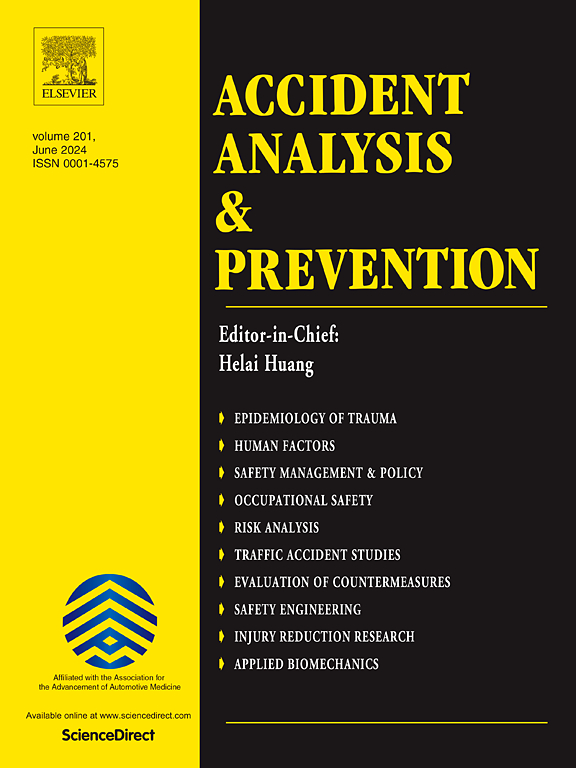Impact of information-assisted modalities and levels on driver takeover performance in conditional automated driving
IF 6.2
1区 工程技术
Q1 ERGONOMICS
引用次数: 0
Abstract
With advances in autonomous driving technology, conditional automated driving (CAD) is gradually entering the consumer market. Before full automation is achieved, however, drivers are still required to take control of the vehicle in complex scenarios. To increase safety and comfort in CAD systems, drivers must be able to respond promptly to takeover requests (TORs). While previous studies have focused on warning signals, it remains unclear how to provide supportive information for complex operations during TORs to optimize post-takeover behavior. This study designed and evaluated a multimodal in-vehicle information assistance system to support safer driver takeovers by providing real-time road information, such as hazard warnings and lane availability. The study introduced two independent variables, three information assistance modalities (visual (V), auditory (A), and visual + auditory (V + A)) and two levels of assistance information (hazard information (H) and hazard information + operational suggestions (HO)). A driving simulator experiment with 56 participants assessed the effects of these conditions on driving performance, gaze behavior, and subjective evaluation. Results demonstrated that the V + A modality combined with HO information achieved the best performance in takeover speed and lane-change safety. Compared to the baseline, takeover time was reduced by 0.46 s, and time-to-collision (TTC) improved by 3.59 s, reducing collision risk. The visual (V) modality enhanced vehicle stability, lowering maximum resultant acceleration by 0.73 m/s2 and reducing abrupt maneuvers. The HO condition improved decision-making quality, increasing overtaking success rates by 6.25 % without adding cognitive load. Additionally, the V + A and HO combination optimized attention allocation. Multisensory integration (V + A) enhanced environmental awareness and decision speed by minimizing information omission through simultaneous visual and auditory cues. These findings provide key insights into designing information assistance for future automated driving, emphasizing the importance of optimizing information delivery in emergencies to improve safety and user experience.
条件自动驾驶中信息辅助模式和水平对驾驶员接管行为的影响
随着自动驾驶技术的进步,有条件自动驾驶(CAD)正逐步进入消费市场。然而,在实现完全自动化之前,驾驶员仍然需要在复杂的场景中控制车辆。为了提高CAD系统的安全性和舒适性,驾驶员必须能够迅速响应接管请求(tor)。虽然以前的研究主要集中在警告信号上,但尚不清楚如何为tor期间的复杂操作提供支持性信息,以优化接管后行为。本研究设计并评估了一个多模式车载信息辅助系统,通过提供实时道路信息(如危险警告和车道可用性)来支持更安全的驾驶员接管。本研究引入了两个自变量,三种信息援助方式(视觉(V)、听觉(A)和视觉+听觉(V + A))和两种级别的援助信息(危害信息(H)和危害信息+操作建议(HO))。一项有56名参与者的驾驶模拟器实验评估了这些条件对驾驶表现、凝视行为和主观评价的影响。结果表明,结合HO信息的V + A模式在接管速度和变道安全性方面具有最佳性能。与基线相比,接管时间减少了0.46秒,碰撞时间(TTC)提高了3.59秒,降低了碰撞风险。视觉(V)模式增强了车辆的稳定性,最大合成加速度降低了0.73 m/s2,并减少了突然机动。HO条件提高了决策质量,在不增加认知负荷的情况下,超车成功率提高了6.25%。此外,V + A和HO组合优化了注意力分配。多感觉整合(V + A)通过同时提供视觉和听觉线索,最大限度地减少信息遗漏,从而提高环境意识和决策速度。这些发现为未来自动驾驶的信息辅助设计提供了关键见解,强调了在紧急情况下优化信息传递以提高安全性和用户体验的重要性。
本文章由计算机程序翻译,如有差异,请以英文原文为准。
求助全文
约1分钟内获得全文
求助全文
来源期刊

Accident; analysis and prevention
Multiple-
CiteScore
11.90
自引率
16.90%
发文量
264
审稿时长
48 days
期刊介绍:
Accident Analysis & Prevention provides wide coverage of the general areas relating to accidental injury and damage, including the pre-injury and immediate post-injury phases. Published papers deal with medical, legal, economic, educational, behavioral, theoretical or empirical aspects of transportation accidents, as well as with accidents at other sites. Selected topics within the scope of the Journal may include: studies of human, environmental and vehicular factors influencing the occurrence, type and severity of accidents and injury; the design, implementation and evaluation of countermeasures; biomechanics of impact and human tolerance limits to injury; modelling and statistical analysis of accident data; policy, planning and decision-making in safety.
 求助内容:
求助内容: 应助结果提醒方式:
应助结果提醒方式:


